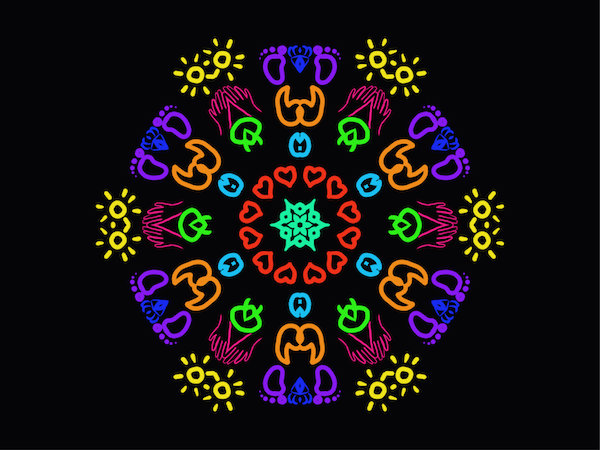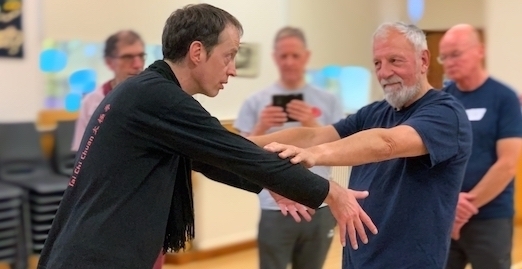Tai Chi Aspects and Meditation in Motion
Tai Chi Aspects are single images and concepts on which one may concentrate while doing the form. They are tools for form refinement. By and by, they will combine into a moving kaleidoscopic picture.
The flow of practicing – Practising the flow
In the end, Tai Chi is still supposed to be one harmonious unity. So why deliberately isolate individual aspects and highlight them?
Flowing movement is widely recognised as one main goal of doing the form. The remaining question is: What is flowing? A small mountain spring, a creak, a river, an ocean? The way from the spring to the sea is a symbol for the process of practicing. If you interpret it as a depiction of the deepening and widening of your own form, one may distinguish three stages of practice, which influence and overlap each other: the learning of the form, the deepening of the movements and meditation in movement.
The spring: Learning the form
When you have memorised the choreography of the form and acquired a rough knowledge of the sequence, you mastered the first steps in Tai Chi. You are now able to move slowly and flowingly, while you still concentrate on the postures and the movements. On this base, you can now direct your attention towards a multitude of Tai Chi Aspects.
The middle course: (Further) independent (home) practice
To deepen your movements, you do the form concentrating on one single Tai Chi Aspect. This is repeated until this aspect has grown into a habit. If it has been successfully internalised in this way, you drop it and turn toward another aspect. This way, one works through different aspects, little by little.
After some time, your breathing will get deeper and calmer, your movements become looser and at the same time more precise. – Your body posture and your way of moving are optimised in small steps, bit by bit.
In the course of this process, the single postures of the form become clearer. They become rooted in our body, our heart and our brain as experiences, expressions of intention and memory shapes.
The opening towards the sea: Meditation in motion
This intense work on single aspects is already the first step towards Tai Chi as “meditation in motion”. If you have finished working on a Tai Chi Aspect – be it after one particular session or at the end of a prolonged phase – you should take time to forget everything and do the form just for the fun of it.

Change and Perfection – Tai Chi Aspects as Tools
In the (purely theoretic) case of a “perfect form”, all Tai Chi Aspects should be realised in their entirety at the same time, by letting the postures of the form – completed by long-standing practice – become bodily reality in space, one by one: the shapes pass by before our inner eye and are formed intuitively. This stream of images is the conscious flow, in which we engage with all our heart and all our strength. That is the determining factor of a fulfilling, vivid practice.
The Tai Chi Aspects enable us to experience this kind of flow, by learning to devote ourselves, our undivided attention and our body feeling at first to one single aspect. This method of practicing will at the same time bypass any obstructive ambition for perfection, any benchmarking of ourselves against ideals or any getting lost in long-lasting practice, during which we move abstract concepts in our heads, feeding the hope that with years going by, the results and insights will appear by themselves.
Instead of this, the Tai Chi Aspects encourage an open and lively mind from the beginning. Progress and challenges may be experienced, named and discussed.
The Tai Chi Aspects are meant to accompany students of the art on their way as hints, tasks, mental exercises. They are thus didactic tools to learn and deepen the form.
Tai Chi as a way of moving – The practical and theoretical background of the Tai Chi Aspects
The video series „Tai Chi Aspects“ deals with learning aspects of Tai Chi’s underlying way of movement. The reflections on this way of moving are based upon a practical approach: The functionality – if you will the “applicability” – of the movements leads the way to refine the external appearance of the form. This is accomplished in a natural way, i.e. by taking into account the material construction of the human body and especially its structural organisation (bones, sinews, muscles, connective tissues and their interlinking). The body is thus understood as a closed, moving system. This way of practicing and reflecting permits a fruitful connection between the insights of Western medicine (anatomy, functionality of body parts and systems) on the one hand, and the Chinese experience-based medicine, which portrays the body as a living system in exchange with its environment, on the other hand.
Starting from this point, many aspects may be described, which will combine into one in the end. Gradually, a multitude of training aspects and possibilities for form refinement will evolve.
Universality and purpose

Does such a description of Tai Chi Aspects, which does not draw upon passed down knowledge and historic practice, but is rather based upon the natural basis of the body and the practical functionality of the movements of the form, have a claim to universality? This is certainly the case as far as the only requirements to learn this way of moving are an average human body and an average ability to concentrate.
The practical significance of the Tai Chi Aspects for Yang style forms
The Tai Chi tradition which led to the development of the Tai Chi Aspects at hand is Yang style Taijiquan as it has been practiced by Cheng Man Ching.
For practical exercises, this means that all those who practise Tai Chi forms in the lineage Yang Chengfu/Cheng Man Ching/William C.C. Chen, may work with the Tai Chi aspects without problems. These forms are the 8 form, the 20 form (60 form, part 1), the 60 form (fusion of 37 Cheng Man Ching form and Yang style long form after Yang Chengfu), the 37 form (Cheng Man Ching short form), the long form (132 Yang style form after Yang Chengfu) as well as the sword form (64 Yang style sword form).
With decreasing degree of relationship of the forms, bigger changes in the outer appearance of the form will be necessary to incorporate single or all Tai Chi Aspects into one’s own practice.
The significance for other styles
If one is practising a totally different Tai Chi form, like e.g. a form of another family style, the question of practicability in one’s own system thus may have to be replaced by the question of how one’s own system answers the addressed aspect or why this aspect is irrelevant in one’s own context of practice. In respect to the plurality of family styles practised, the Tai Chi Aspects are not so much a „Guide to Truth and Correctness“, but rather an independent contribution to practising and experimenting, as well as a source of ideas for those thinking out of the box. The Tai Chi Aspects are thus explicitly also meant to be a means for cross-style exchange.
A link between form practice for health and martial arts – The place of the Tai Chi Aspects
Do the form like you are fighting and fight like you are doing the form!
What could that possibly mean? However one may interpret this saying, it certainly does not mean that you can become a fighter by practising the form for years. This will only work inside your own head or with your own practice group in which everyone is trained to strictly obey the offensive and defensive patterns that have been trained before.
If one wants to do Tai Chi not only for health, but also as a martial art, one must train it as such. The only way is by means of partner exercises – these cannot be replaced by anything else. The Tai Chi Aspects support the development of a way of moving which gives the body the ability to react flexibly and functionally.
When and how one has to react in the situation of a fight, can only be learnt by experience. – Be it form application, Push Hands, boxing or free fighting „without rules“: You have to practise what you want to master. Mental simulation in our heads does not suffice.
To all Tai Chi fans who are also interested in the martial arts aspect of Tai Chi, we can only warmly recommend our #martialmonday for some insights into the partner work in our school.
Author: Tai Chi Studio
Images: Nils Klug, Nils Elders
Graphic: Gabi Kannenberg
Recommended reading
Tai Chi at home
Tai Chi at home? Is it possible to learn Tai Chi online and train at home? It may not be the first choice for all of us, but sometimes – and for some people – it may be the only way. So, why not at least give it a try?
Join us on our journey to create a free Tai Chi online course! We will start with a simple, space-saving form of 8 movements…
Tai Chi 8 movements
The Tai Chi 8 movements is a form created by Nils Klug for his students. Its aim is to enable home training of the different aspects of the Tai Chi form (Yang Style 60 movements) over a longer period of time. The students, long-time students as well as beginners, may train the whole 60 form, the first part or as many postures as they have already learned. Doing this, they work on different aspects, following the instructions and demonstrations of the additional videos. In situations of restricted space, they may also stick to the 8 movements presented below. The 8 form is suitable for „endless“ repetition.
- Always move “just enough” (passive stepping)

- Tai Chi stepping 9/10 – Always leave the line of attack

- Tai Chi stepping 8/10 – Match your steps

- Tai Chi stepping 7/10

- Tai Chi stepping 6/10

- Tai Chi stepping 5/10 – Watch your back

- Tai Chi stepping Rule 4 – Keep connected to the ground

- Tai Chi stepping rule 3

- Tai Chi stepping rule 2

- Tai Chi stepping rules

- PLAY TAI CHI – Tai Chi Aspects

- Fast Forward – Tai Chi Aspects

- Pause – and Rewind – Tai Chi Aspects

- STOP – Tai Chi Aspects

- Grow like a plant – 5 Tipps for gentle movements

- Integrating the Baihui – keep calm and find your centre! – Tai Chi Aspects

- Taking a warm shower – Tai Chi Aspects

- Letting go – Tai Chi Aspects

- Free Tai Chi online course complete!

- Spirals – Tai Chi Aspects























